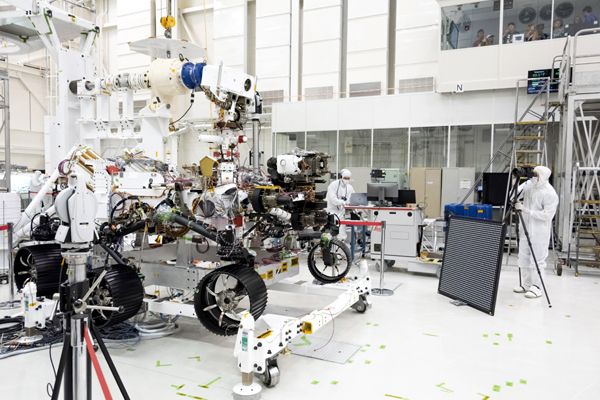
NASA / JPL - Caltech
NASA 'Optometrists' Verify Mars 2020 Rover's 20/20 Vision (News Release)
Equipped with visionary science instruments, the Mars 2020 rover underwent an "eye" exam after several cameras were installed on it. The rover contains an armada of imaging capabilities, from wide-angle landscape cameras to narrow-angle high-resolution zoom lens cameras.
"We completed the machine-vision calibration of the forward-facing cameras on the rover," said Justin Maki, chief engineer for imaging and the imaging scientist for Mars 2020 at JPL. "This measurement is critical for accurate stereo vision, which is an important capability of the vehicle."
To perform the calibration, the 2020 team imaged target boards that feature grids of dots, placed at distances ranging from 1 to 44 yards (1 to 40 meters) away. The target boards were used to confirm that the cameras meet the project's requirements for resolution and geometric accuracy. The cameras tested included two Navcams, four Hazcams, the SuperCam and the two Mastcam-Z cameras.
"We tested every camera on the front of the rover chassis and also those mounted on the mast," said Maki. "Characterizing the geometric alignment of all these imagers is important for driving the vehicle on Mars, operating the robotic arm and accurately targeting the rover's laser."
In the coming weeks, the imagers on the back of the rover body and on the turret at the end of the rover's arm will undergo similar calibration.
Mounted on the rover's remote sensing mast, the Navcams (navigation cameras) will acquire panoramic 3D image data that will support route planning, robotic-arm operations, drilling and sample acquisition. The Navcams can work in tandem with the Hazcams (hazard-avoidance cameras) mounted on the lower portion of the rover chassis to provide complementary views of the terrain to safeguard the rover against getting lost or crashing into unexpected obstacles. They'll be used by software enabling the Mars 2020 rover to perform self-driving over the Martian terrain.
Along with its laser and spectrometers, SuperCam's imager will examine Martian rocks and soil, seeking organic compounds that could be related to past life on Mars. The rover's two Mastcam-Z high-resolution cameras will work together as a multispectral, stereoscopic imaging instrument to enhance the Mars 2020 rover's driving and core-sampling capabilities. The Mastcam-Z cameras will also enable science team members to observe details in rocks and sediment at any location within the rover's field of view, helping them piece together the planet's geologic history.
JPL is building and will manage operations of the Mars 2020 rover for the NASA Science Mission Directorate at the agency's headquarters in Washington. NASA will use Mars 2020 and other missions, including to the Moon, to prepare for human exploration of the Red Planet. The agency intends to establish a sustained human presence on and around the Moon by 2028 through NASA's Artemis lunar exploration plans.
To submit your name to travel to Mars with NASA's 2020 mission and obtain a souvenir boarding pass to the Red Planet, go here by Sept. 30, 2019:
https://go.nasa.gov/Mars2020Pass
Source: Jet Propulsion Laboratory

No comments:
Post a Comment